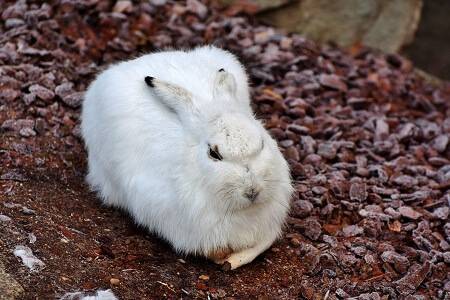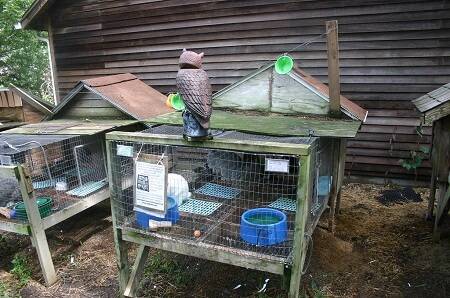During the cold winter months, domestic rabbits require special care and attention to remain happy and healthy. Rabbits are susceptible to the cold due to their small size and inability to regulate their body temperature. Rabbit owners must take the necessary steps to protect their rabbits from the elements and help them stay warm when temperatures drop.
In this article, we have covered how to properly care for rabbits in the wintertime by addressing their shelter, bedding, diet, and other needs. Following these recommendations will help ensure your rabbits stay comfortable and thrive despite the cold weather.

What Is The Ideal Temperature For Rabbits?
Rabbits are warm-blooded animals. So, sudden temperature change has a substantial and challenging impact on every animal, including rabbits. The ability to survive depends mostly on quality food, water, and surroundings.
According to most of the scientific research, 50- 70 °F (10 – 22 °C) is the ideal temperature for rabbits. Rabbits can tolerate from 40 °F (5 °C) to 80 °F (26 °c). This is the ideal temperature for rabbits.
Without proper shelter, it is impossible to survive for rabbits in severely cold weather.
Now, you may wonder how the wild rabbit survives during the snowfall.
It’s possible because of the rabbit’s genetics, lifestyle, and food habits. Moreover, wild rabbit makes underground shelters, as I mentioned earlier in this article.
How to Keep Rabbits Warm In Winter?
Well, it’s not a hard job to keep your bunny warm and cozy during the rough winter in the outdoor hutch. If you are sincere enough, you can do it by following the points I have covered here.
1. Adjust the Hutch
Making some simple changes to your rabbits’ hutch will go a long way in keeping them warm when the weather turns cold. If you can, moving the hutch into your garage or an enclosed porch gets it out of the elements – just be sure they’ll still get enough daylight and ventilation.
If indoor space isn’t possible, start by checking over the hutch for any gaps or holes where drafts of cold air could creep in. It’s pretty common for wood to warp or wear down over time. Seal up any problem spots with caulk or weatherproof sealant, and line the inside walls with newspaper for extra insulation.
Those wire mesh doors may be nice for summer breezes, but they let in way too much cold in the winter. Just tape some plastic wrap over the doors to block wind and snow, leaving a small gap at the bottom so the hutch doesn’t get too stuffy.
While you’re at it, pile on more insulation up top too. Layers of blankets or old towels topped with a tarp will not only keep in the heat but prevent melted snow from dripping down into the hutch – no bunny wants an icy shower!
Positioning the hutch entrance away from the prevailing winds could make a big difference as well. You could even set up temporary wind blocks around one or two sides of the hutch to provide a buffer from winter weather. Just a few simple tweaks like these will help keep your rabbits feeling cozy when it’s cold out.
Related: Can Male Rabbit Stay with Babies?
2. Provide warm bedding
Here are some tips for providing warm bedding for rabbits in the winter:
First, set up an enclosed, box-like bed inside the hutch for them to snuggle into. Cardboard boxes work great for this. Make sure to cut an entry hole they can hop in and out of easily.
Line the bottom and sides with newspaper for insulation from the cold. Then fill it up with soft bedding materials. Good options are straw, hay, or shredded paper bedding. Just don’t use fabrics like blankets that they could potentially chew on or get tangled in.
Aim for at least 4-6 inches of fluffy bedding material. This gives them something cozy to burrow into when they sleep. And be sure to replace the bedding frequently, as soon as it starts to look dirty or flattened down. Nobody wants to sleep on a cold, damp floor!
You can even use hand warmers underneath the bedding to provide some gentle warmth, but avoid anything electrical that could pose a fire hazard. The key is setting up a space insulated from the cold and filled with fresh, inviting material your rabbits will love snuggling into all winter long. Their bed should be the coziest spot in the hutch!

3. Add insulation
One of the easiest ways to help your rabbits stay toasty is to pack straw all around the inside of their hutch – it acts like insulation between them and the cold outside. Just grab some fresh, dry straw and start stuffing it into any gaps or open spaces along the walls. Focus on packing it tightly around where they sleep and lay around. The straw traps heat to keep the inside warm.
You’ll want to replace the straw often before it gets damp or dirty. Damp straw can make things colder. Some folks even line the walls with cardboard or those rigid foam boards before adding straw over top, for extra insulating power.
Don’t forget to add extra straw or hay inside any enclosed little houses or igloo-style hides you have in there too. This helps hold in their body warmth when they hunker down.
Oh, and putting a layer of straw or a tarp over the roof prevents cold air from seeping in from above. You can also cover the entrance with a flap or curtain to keep heat inside. Just a few simple tricks like these can make all the difference in keeping your rabbits cozy and comfortable!
Related:
4. Prevent water freezing
Keeping your rabbits hydrated can be tricky when their water bottles and bowls keep turning to ice cubes! An easy fix is to wrap plastic bottles with towels, rags, or foam insulation. This helps slow down freezing so you don’t have to change them out as often.
You can also pick up special winter bottles that have built-in insulation wraps. Just have some extras on hand so you can swap a frozen one out for a fresh thawed bottle quickly.
Ceramic crocks or heavier bowls hold heat better than plastic or lightweight metal too. Elevate them off the hutch floor if you can, so they don’t lose heat to the frozen ground.
Be sure to check the water supply often – like a few times a day if it’s bitterly cold. It’s no fun trying to lap up a solid chunk of ice! Topping off bottles and bowls with fresh water helps reduce freezing too.
You want to make sure your rabbits stay hydrated because they’ll drink more when eating dry hay and foods. A few simple tricks like insulation wraps and heavier dishes keep their water flowing – not frozen!
5. Allow exercise
Just because it’s cold out doesn’t mean your rabbits should turn into couch potatoes! Rabbits need opportunities to run and play even in winter.
Bringing them into a safe, bunny-proofed room in your home for short periods is a great way to let them get some zoomies out. You’ll just want to keep an eye on them so they don’t chew or dig at anything they shouldn’t.
If they spend tons of time indoors though, outdoor bunnies can start shedding their thick winter fur coats. So find a balance between playtime inside and still spending most of their time in their outdoor housing.
You can also clear snow in a protected section of their outdoor run space. That way they can hop around and get fresh air on warmer winter days above freezing. Just keep a close eye on any signs of shivering when they’re out.
Make sure to limit their outdoor playtime on bitterly cold or wet days though. Rabbits can handle some cold, but not extended time in freezing winds or dampness.
Getting in some active playtime avoids boredom and keeps your rabbits healthy. A little indoor freedom or clearing outdoor space gives them room to exercise safely even when it’s chilly out. Just use common sense based on weather conditions.
6. Watch for health issue
Even with all your winter-proofing efforts, keep an eye out for any signs of illness in your rabbits as the weather gets cold. Sniffles, coughs, sneezes, and runny noses can indicate respiratory issues.
Check their eyes too – any goopy discharge or redness may signal an infection brewing. And watch for dirty staining around the eyes or nose, which can be caused by them pawing at irritation.
Listen for wheezing, coughing, or loud breathing, which could mean pneumonia from the chilly air. Make sure the hutch isn’t too poorly ventilated though – you still need fresh airflow.
Feel their ears and feet regularly to catch frostbite early. Skin will turn red and irritated if exposed to freezing temps for too long.
If you notice decreased energy or appetite, get them warm and hydrated. Drinking less water when they eat dry foods can cause issues.
Take action right away if you spot any of these problems to keep them from worsening. And when in doubt, take them to the vet for a checkup so they can get back to being healthy, happy winter bunnies!
What can I put in my rabbit’s cage to keep him warm?
To keep your rabbit warm in its cage during winter, provide 4-6 inches of soft bedding like hay or straw for burrowing and insulation. Avoid fabrics that can be chewed. You can also use a SnuggleSafe heat disk or bottle under the bedding, but monitor closely and keep cords secured. Packing extra straw around the cage walls also helps conserve heat inside.
Is it OK to leave a rabbit outside in the winter?
Outdoor rabbits can stay outside in winter if their hutch is draft-free, insulated, and protected from the elements. Provide ample warm bedding and check often that they are dry and have unfrozen water.
How do I know if my rabbit is cold?
Signs of a cold rabbit include shivering, ears feeling cold to the touch, low energy/activity levels, pressing belly to the ground, and huddling for warmth.
How do I know if my rabbit is warm enough?
A comfortable rabbit is active, has pink warm ears, does not shiver or huddle, and enjoys sleeping stretched out.
How do you heat a rabbit cage?
Use thick bedding, cover the hutch in insulation like straw, locate the hutch in a sheltered area, use heating pads/disks safely, and move the hutch to a heated area if the temperature is extremely low.
Wrapping Up
Caring for rabbits in winter takes some extra preparation and adjustments. But it is completely doable with proper housing and attentive care. By insulating their hutches, providing ample warm bedding, ensuring access to unfrozen water, allowing for exercise time, and monitoring their health, you can keep your rabbits just as happy and healthy during cold months. With a few simple tweaks to their housing, diet, and care routine, your rabbits can thrive all winter long in comfort and safety.
Reference:
Recent Posts
You may have already adopted a bunny or are planning to get one. Rabbits are a great source of pleasure for a family, especially children. They are peaceful and need moderate space for...
Perhaps, you have already adopted a bunny and now looking for an effective suggestion for a rabbit cage setup. Well, setting up a rabbit cage is not a difficult task indeed. If you have the proper...
